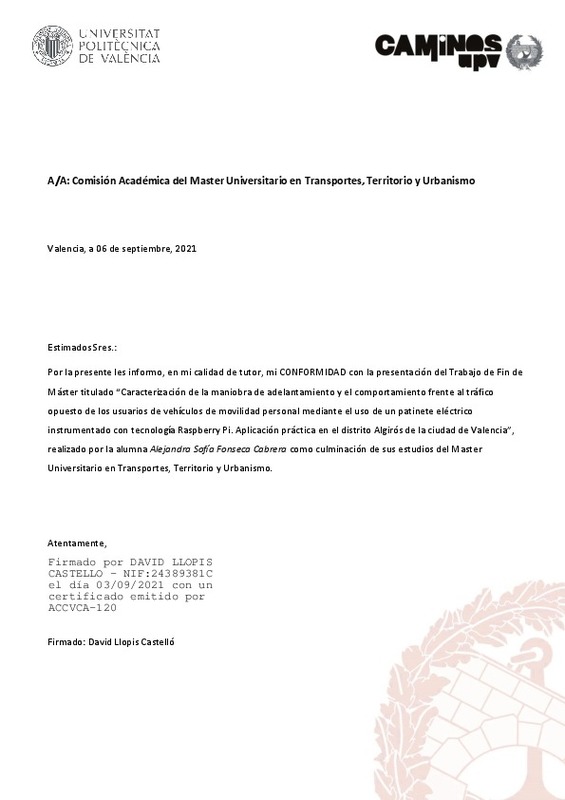

Caracterización de la maniobra de adelantamiento y el comportamiento frente al tráfico opuesto de los usuarios de vehículos de movilidad personal mediante el uso de un patinete eléctrico instrumentado con tecnología Raspberry Pi. Aplicación práctica en el distrito Algirós de la ciudad de Valencia.
RiuNet: Repositorio Institucional de la Universidad Politécnica de Valencia
JavaScript is disabled for your browser. Some features of this site may not work without it.
Buscar en RiuNet
Listar
Mi cuenta
Estadísticas
Ayuda RiuNet
Admin. UPV
Caracterización de la maniobra de adelantamiento y el comportamiento frente al tráfico opuesto de los usuarios de vehículos de movilidad personal mediante el uso de un patinete eléctrico instrumentado con tecnología Raspberry Pi. Aplicación práctica en el distrito Algirós de la ciudad de Valencia.
Mostrar el registro completo del ítem
Fonseca Cabrera, AS. (2021). Caracterización de la maniobra de adelantamiento y el comportamiento frente al tráfico opuesto de los usuarios de vehículos de movilidad personal mediante el uso de un patinete eléctrico instrumentado con tecnología Raspberry Pi. Aplicación práctica en el distrito Algirós de la ciudad de Valencia. Universitat Politècnica de València. http://hdl.handle.net/10251/175929
Por favor, use este identificador para citar o enlazar este ítem: http://hdl.handle.net/10251/175929
Ficheros en el ítem
Metadatos del ítem
| Título: | Caracterización de la maniobra de adelantamiento y el comportamiento frente al tráfico opuesto de los usuarios de vehículos de movilidad personal mediante el uso de un patinete eléctrico instrumentado con tecnología Raspberry Pi. Aplicación práctica en el distrito Algirós de la ciudad de Valencia. | |||
| Autor: | Fonseca Cabrera, Alejandra Sofía | |||
| Director(es): | ||||
| Entidad UPV: |
|
|||
| Fecha acto/lectura: |
|
|||
| Resumen: |
[ES] Con el paso de los años, el transporte se ha convertido en uno de los sectores que mayor contribución hace a la contaminación ambiental, y por ende al cambio climático. Por ello, las ciudades se han enfocado a modificar ...[+]
[EN] Over the years, the transport sector has become one of the most significant contributors to the environmental pollution, and thus to climate change. For this reason, cities started to modify their mobility systems ...[+]
|
|||
| Palabras clave: |
|
|||
| Derechos de uso: | Reserva de todos los derechos | |||
| Editorial: |
|
|||
| Titulación: |
|
|||
| Tipo: |
|
Localización
recommendations
Este ítem aparece en la(s) siguiente(s) colección(ones)
-
ETSICCP - Trabajos académicos [2365]
Escuela Técnica Superior de Ingenieros de Caminos, Canales y Puertos







